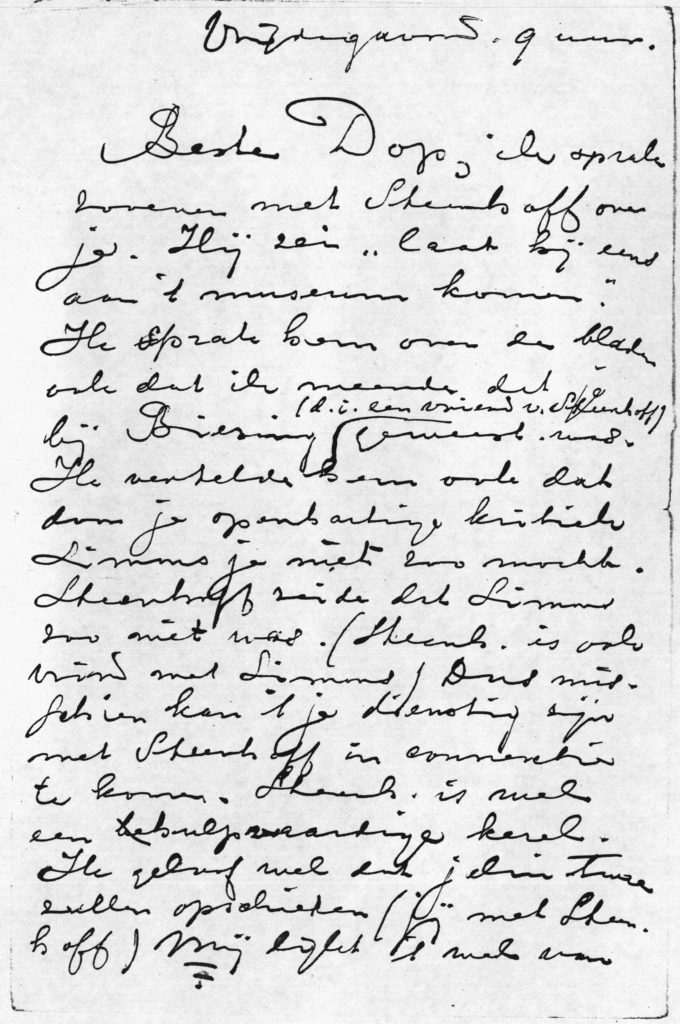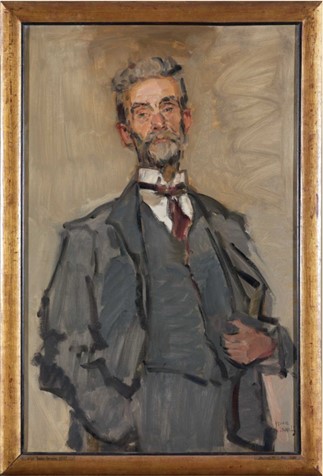by Leo Jansen

When reading Mondrian’s letters, it soon becomes evident that the artist was an accomplished networker. Whether this was because of his membership of artists societies, his attendance at openings and conferences, or his visits to establishments where he met kindred spirits – he knew where and how to gain useful contacts and how to maintain them. He also moved with ease through the well-to-do middle class circles where he might be able to meet prospective buyers of his work. But networking is not merely about taking, it involves giving as well. A short letter to one of his friends perfectly illustrates how this worked.
The letter is addressed to Dutch poet, playwright and critic Dop Bles (1883-1940). Mondrian met him in 1912 during his first stay in Paris, which also was Bles’ residence. According to Mondrian biographer Hans Janssen, the two spent a great deal of time together. When in the summer of 1914 the First World War broke out, Mondrian found himself in the Netherlands and he decided to wait out the end of the war in his home country. During the first few weeks, he sent two postcards to Bles to inform him he was stranded and to ask Bles about himself and his family – a clear indication of his fondness for Bles. A few months later, the latter decided to return to the Netherlands – which had remained neutral – and there the two friends were able to reconnect.
The text of the letter reads as follows:
Friday evening. 9 o’clock. Dear dop, I have just spoken to Steenhoff about you. He said “have him drop by at the museum some time.” I talked with him about the magazines, and also that I thought you had been to see Biesing (a friend of v. Steenhoff’s). I also told him that because of your candid criticism, Simons was not too fond of you. Steenhoff said Simons wasn’t like that. (Steenh. is also friends with Simons.) So it might be to your advantage to get in touch with Steenhoff. Steenh. is rather an obliging sort of fellow. I’m inclined to think the two of you will get along (you and Steenhoff). Personally I believe it is important that you manage to speak with Steenh. tomorrow. Try and do so first thing in the morning, then you can go back in the afternoon, if necessary. I have to go out with these people early tomorrow morning, but I will deliver this at your hotel before that time. Well, see you tomorrow evening, at 7:30 at your hotel. Au revoir Piet. Enter museum through left door, then if you turn left and walk straight on, you will arrive at the director’s office, then ask the attendant to announce you to Mr Steenhoff. I have mentioned your name, and the rest of it; the fact that I sent you, etc., you can tell Steenhoff yourself. Steenh. seemed to attach some importance to Koster being your friend.
From the text it would appear that Mondrian wanted to help his friend by introducing him to the influential Willem Steenhoff (1836-1932). He was one of the art tsars of the Netherlands: deputy director of the Paintings Department of the Rijksmuseum and an authoritative art critic with an open mind to the most modern art. During Mondrian’s Parisian years (1912-1914) Steenhoff arranged a copying assignment at the Louvre for him to supplement his income (by way of a thank you, Mondrian sent a number of picture postcards from the Louvre to Steenhoff). Later, Steenhoff was also to persuade fellow art tsar H.P. Bremmer to support Mondrian financially by way of an allowance in exchange for a number of art works per year, which was to provide essential financial footing for the artist during the years between 1916 and 1919. Steenhoff was, in short, a man of influence.
Steenhoff seemed inclined to receive Bles; this much Mondrian had achieved by mentioning a thing or two about the latter. With ‘I talked with him about the magazines’ Mondrian must next have been referring to the magazines that wrote about art and literature and that could possibly provide employment for Bles, who also had experience as an editor. As a theatre critic he had a reputation for being dead set against anything conventional, and he advocated innovation, which naturally ruffled quite a few feathers. Among those affected was Leo Simons, the founder and director of the Maatschappij voor Goede en Goedkoope Lectuur (the Society of Good and Cheap Literature, better known as The World Library), whose name was mentioned in the letter. Fortunately, Steenhoff did not consider this too much of a problem, however, because … he knew Simons too, and he did not think the latter would hold Bles’ sharp pen against him: ‘Steenhoff said that Simons was not like that.’

Mondrian knew that Bles also had a good eye for art. Apparently, on the strength of that quality, Bles had meanwhile also offered his services to art dealer J.J. Biesing in The Hague – a fortunate coincidence because… this too was one of Steenhoff’s connections. Bles himself even contributed to increasing the meeting’s chances of success, although in a somewhat patronising manner it would seem: in the second postscript at the end of the letter, Mondrian adds that Steenhoff ‘seemed to attach some importance’ to the poet being on good terms with one Koster. This is probably a reference to Dirk Coster, a man of letters who travelled up and down the country delivering lectures on world literature and who was renowned for his exhilarating talks. He too was critical of the literature of his day, which he found lacking in character and passion.
All in all it becomes clear that Bles was in need of a job and an income, which is confirmed by the sentence: ‘it might be to your advantage to get in touch with Steenhoff’. No doubt Mondrian’s assessment was correct. He introduced the controversial playwright and critic to an influential acquaintance who was receptive to innovation and who in his turn had ‘friends’ who held similar views. It is also characteristic that Mondrian advises Bles not to waste any time: ask to be received first thing tomorrow morning, he urges – even though Mondrian will only deliver the letter to Bles that same morning – and be prepared to at once go again in the afternoon, if necessary. A good sense of timing is an inherent feature of the higher art of networking.
What the tangible results of Mondrian’s interventions were, is – unfortunately – (as yet) unknown. Possibly one H.J. Geerkens, whose name, presumably by Bles, was jotted on the letter, played a part thanks to Steenhoff’s intercession. Whatever the case may be, it is obvious that Mondrian, who himself was greatly indebted to Steenhoff, was also prepared to share his network with a friend in need. In this case, that even resulted in a long-term relationship between Steenhoff and Bles. The fact that on New Year’s Eve 1928, Bles was among those invited to grace a celebration at Museum Mesdag in The Hague to mark the end of Steenhoff’s career in civil service, clearly attests to this.
A noteworthy detail from the letter is that Bles was staying at a hotel and apparently did not have a permanent address. In conjunction with the above, this provides an additional clue as to the probable dating of the letter. It seems evident that we are dealing with the period directly following the previously mentioned return of Bles to the Netherlands in the spring of 1915. That is why for the time being, the dating will be roughly determined at late 1915.